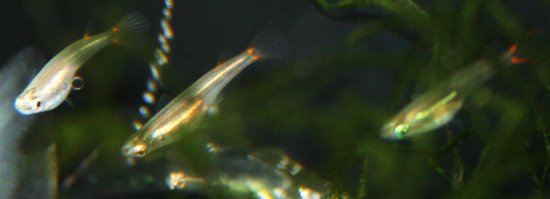Mekong Rice Killies By Joe Graffagnino
I was recently at the latest meeting of the Northeast Council of Aquarium Societies in Connecticut and had no intention of purchasing any new fish, since my aquariums were already very well stocked. As I wandered around, I came to Frank Greco’s sales table. Frank has the most interesting and rare fish that you will ever see. I strolled around the table and my eye caught something small flash by. It was a really small fish with a silver body; the male has an orange red coloration on its anal fin. I had to ask, and that, of course, was my undoing.
Frank told me that particular fish was commonly called the Mekong Red Lampeye Rice Killifish. The fish are found in the Mekong River delta in Northern Thailand. The adult of this species doesn’t get over ½ inch in size. There are approximately 2 dozen varieties of rice killifish. The nice thing about these fish is they can live and spawn in aquariums as small as 2 gallons. All that is needed is a sponge filter and java moss. Since these fish are really small, frozen baby brine shrimp works well (regular brine shrimp and Daphnia are too large for them). They also thrive on live microworms, vinegar eels and crushed flake food.
When the female is carrying eggs, she carries them on her body. The eggs are slightly adhesive so when the female swims through java moss the egg rubs off the mother and attaches to the java moss. The male fish follows closely behind and fertilizes the egg. At times I have seen one female carrying several eggs. The eggs are quite large for such a small fish and they resemble clear to opaque killie eggs. As the embryo matures, the egg darkens. Within a week the fry are free swimming. The parents ignore the fry so you don’t need another tank to rear the fry to adulthood. You can’t ask for better than that in a fish!
The water parameters are basic with the pH 7.0, GH of 3, and the temperature 78 – 80 degrees Fahrenheit. This is a great and unique little fish and quite prolific once they get started. Because of their small size, I would maintain them in a species only tank. Enjoy them and share them with other hobbyists.


